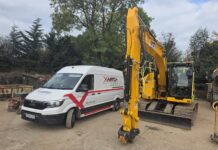HAND-ARM Vibration Syndrome (HAVS) is continuing to plague construction employees who regularly use power tools and other vibrating equipment for long periods of time.
This is despite the fact there are plenty of precautions to reduce the risks according to workplace equipment supplier Slingsby.
HAVS, which is also known as Vibration White Finger or dead finger, is usually a permanent condition that is caused by the extended use of tools and machinery such as power drills, chainsaws and other hand-held or hand-guided equipment.
It is particularly prevalent in the construction sector.
Symptoms can include poor circulation which can result in the fingers turning white, a tingling sensation and numbness.

The Medical Research Council estimates that as many as 300,000 employees in the UK suffer from HAVS and more than one million people are exposed to vibrations above safe levels set by the Health & Safety Executive’s Control of Vibration at Work Regulations 2005.
This legislation states that employers must protect employees from vibration exposure and take action to lower the risks of HAVS exposure through an appropriate and continual monitoring system.
Lee Wright, Marketing Director at Slingsby which supplies more than 35,000 workplace products across all industries, said, “HAVS is an extremely common industrial injury that can cause substantial disruption to a person’s life if it is ignored.
“Although it commonly affects the construction sector, people working in all industries who use vibrating equipment can be at risk.
“The vibrations can pass through the fingers, hands and arms causing damage to small nerves and blood vessels.
“Anyone who ignores the symptoms and carries on using the offending equipment is risking their long-term health. Employers have a responsibility to monitor and manage their employees’ exposure to vibrations. Plus there can be significant penalties for businesses that breach the HSE’s guidelines with recent estimates from insurer AXA suggesting that average claims for HAVS are approximately £70,000 once legal fees are taken into account.
“Sometimes it may be possible to find alternative ways of doing things, that don’t require the use of vibrating equipment, but if this isn’t possible there are lots of precautions that employers can take to reduce the risks of HAVS.
“All equipment and machinery should be regularly checked in order to reduce vibrations caused by general wear.”










